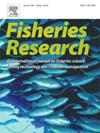Quantifying distinctions in the otolith shape of morphologically similar Sub-Antarctic grenadier species (Macrourus) to assess fishery observer identifications.
IF 2.3
2区 农林科学
Q2 FISHERIES
引用次数: 0
Abstract
Accurate bycatch species identification is crucial in commercial fisheries, as species vary in vulnerability to fishing pressure. Fishery observer experience also varies, which can form inaccurate commercial fishing datasets and compromise species-level identifications. At the sub-Antarctic Heard Island and McDonald Islands (HIMI), four grenadier (Macrourus) species represent a high bycatch percentage in the Patagonian toothfish (Dissostichus eleginoides) demersal longline fishery. Current fisheries bycatch limits for Macrourus species are categorised into two species pair groups: shallow-water living (Macrourus caml, M. whitsoni) and deep-water living (M. holotrachys, M. carinatus). However, misidentification by fishery observers due to similar characteristics limits high taxonomic resolution within catch records. Therefore, improving observer accuracy of bycatch stock identification from pooled Macrourus Genus level to species level is required within HIMI fisheries. We photographed 800 otoliths across the four Macrourus species collected from HIMI’s longline fishery bycatch (2015–2021). Macrourus otolith shape and outline analysis was conducted using shapeR, while random forest models (RFM) coupled initial observer identifications with otolith morphometrics to predict species identification within each bycatch pair. RFM prediction accuracy varied from > 95 % for M. holotrachys and M. caml to 70 % and 60 % for M. carinatus and M. whitsoni respectively, highlighting otolith width, perimeter, and length as important predictor morphometrics. Otolith elliptical Fourier constructions of M. whitsoni and M. carinatus displayed dorsal margins with prominent outward shifts, which can visually assist onboard identification of these species. Overall, our research establishes baseline otolith morphometric data for four Macrourus species, supporting the refinement of historical Genus-level bycatch identifications to each species pair group at HIMI’s commercial fishery.
量化形态相似的亚南极掷弹兵物种(大掷弹兵)耳石形状的差异,以评估渔业观察员的鉴定。
准确的副渔获物种类鉴定对商业渔业至关重要,因为各种物种对捕捞压力的脆弱性各不相同。渔业观察员的经验也各不相同,这可能形成不准确的商业捕鱼数据集,并损害物种水平的识别。在亚南极的希尔德岛和麦克唐纳群岛(HIMI),巴塔哥尼亚齿鱼(Dissostichus eleginoides)的海底延绳钓渔业中,四种掷弹鱼(Macrourus)代表了很高的副渔获率。目前大型鱼类的渔业副渔获量限制分为两类:浅水生物(大型caml, M. whitsoni)和深水生物(M. holotrachys, M. carinatus)。然而,由于相似的特征,渔业观察员的错误识别限制了捕捞记录的高分类分辨率。因此,在HIMI渔业中,需要提高副渔获量识别的观测者准确性,从池属水平提高到种水平。我们拍摄了来自HIMI延绳钓副渔获(2015-2021)的四种大型物种的800块耳石。使用shapeR进行宏观耳石形状和轮廓分析,而随机森林模型(RFM)将初始观察者识别与耳石形态测量相结合,以预测每个副捕获对中的物种识别。RFM预测精度从holotrachys和caml的>; 95 %到M. carinatus和M. whitsoni的分别为70 %和60 %,突出了耳石宽度、周长和长度是重要的预测形态测量指标。M. whitsoni和M. carinatus的耳石椭圆傅里叶结构显示出突出的向外移动的背缘,可以在视觉上辅助这些物种的船上识别。总体而言,我们的研究建立了四种大型鱼类的基线耳石形态测量数据,支持对HIMI商业渔业中每个物种对组的历史属级副渔获物鉴定的改进。
本文章由计算机程序翻译,如有差异,请以英文原文为准。
求助全文
约1分钟内获得全文
求助全文
来源期刊

Fisheries Research
农林科学-渔业
CiteScore
4.50
自引率
16.70%
发文量
294
审稿时长
15 weeks
期刊介绍:
This journal provides an international forum for the publication of papers in the areas of fisheries science, fishing technology, fisheries management and relevant socio-economics. The scope covers fisheries in salt, brackish and freshwater systems, and all aspects of associated ecology, environmental aspects of fisheries, and economics. Both theoretical and practical papers are acceptable, including laboratory and field experimental studies relevant to fisheries. Papers on the conservation of exploitable living resources are welcome. Review and Viewpoint articles are also published. As the specified areas inevitably impinge on and interrelate with each other, the approach of the journal is multidisciplinary, and authors are encouraged to emphasise the relevance of their own work to that of other disciplines. The journal is intended for fisheries scientists, biological oceanographers, gear technologists, economists, managers, administrators, policy makers and legislators.
 求助内容:
求助内容: 应助结果提醒方式:
应助结果提醒方式:


